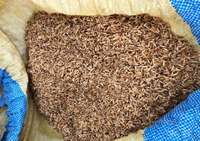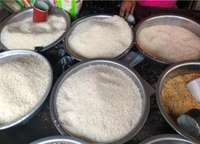Introduction
This article describes a cost-effective way of assessing the quality of paddy rice (Oryza sativa) seed before storing and planting. You will need water, salt, and eggs. This technique has been tried and tested by more than ten rice farmers in the Atwima Nwabiagya district in Ghana, West Africa. These farmers adopted it based on natural observation and interaction with other farmers.
Seed quality assessment

Figure 13. High-quality paddy rice obtained after seed assessment before planting. Source: Abena Konadu Oppong
Seed is an important input of agricultural production systems. Farmers need quality seeds to achieve high yields of marketable produce. To attain high quality seeds for crop production, assess seeds before planting (Kim et al., 2022). Assessing the quality of seeds prior to planting ensures only quality and viable seeds are used in production.
Seed quality assessment involves processes for evaluating the viability and vigor of seeds before planting. Seed viability is a measure of the quantity of viable seeds, signifying those capable of germination and is often measured by percent germination. Vigor indicates the ability of seed to grow into productive plants when cultivated under conditions typical to a farmer’s field (Farooq et al., 2010).
Considering the importance of seed quality assessment, the cost of modern seed assessment techniques, and that most smallholder farmers are low-income earners, a cost-effective and low-resource way of assessing the quality of seeds (in this case paddy rice) needs to be investigated.
How important is seed quality assessment?

Figure 14. Milled high-quality paddy rice. Source: Abena Konadu Oppong
Assessing the quality of seeds before planting ensures only viable seeds are used in production and can lead to high productivity. For example, in coordinated trials across multiple locations in India, the adoption of high-quality seeds increased crop productivity by an average of 20 to 30% (Chowdhary, 2004). Oppong (2020) found that not all farmers in Ghana assess the quality of their seeds. However, those who do are generally rewarded with high-quality rice. One farmer who consistently attained high-quality rice did germination testing with a small handful of seeds and only planted seeds with 80-90% germination rate. Farmers who did not engage in seed quality assessment and used poor-quality seeds for production had low-quality rice. We now know that assessing the quality of seeds results in high-quality produce.
High-quality paddy rice should be productive (a high-yielding variety), with full-sized seeds that are free of disease and yellowish, bright or shiny, and not over-dried (Oppong, 2020; Figure 13). When milled, the rice grains should be unbroken, white, and aromatic (Figure 14).
How to use water, an egg, and salt to assess paddy rice seeds
- Gather materials: A plastic container, freshwater, salt, a raw egg, and paddy rice seeds. The egg should not be more than three weeks old.
- Prepare the container with water: Clean a container or vessel to make sure there are no foreign particles in the container. Fill it with water, taking into consideration the amount of water should be sufficient to cover the paddy rice seeds completely.
- Add ingredients: Add an appropriate amount of salt into the water. In the absence of a specific gravity meter, a raw egg can be used to indicate how much salt can be used. Place the egg into the salt solution. Add salt until the egg floats, indicating that the density of the salt solution is high enough for good separation between low- and high-quality seeds. Remove the egg, as it has now served its purpose. Testing at ECHO, with several chicken eggs and a duck egg, showed that a 10% salt solution (equivalent of 2 kg salt per 20 L of water) was the minimum amount required for an egg to float. Kim et al. (2022) suggested a 21% salt solution (4.2 kg salt in 20 L of water), an amount that will cause the egg to float higher in the water (Figure 15). Experiment to determine the minimum amount of salt that causes low-quality/damaged seeds to float while allowing quality seeds to sink.

Figure 15. Chicken egg in 500 ml of water with no salt (left), 50 g salt (10% salt solution; middle), and 100 g (20% salt solution;right). Note that the egg sank with no salt, floated with 50 g salt, and floated a little higher in the water with 100g salt. A 10% salt concentration was the minimum amount it took for three chicken eggs and a duck egg to float. Corresponding specific gravity values were 1.000 for no salt and 1.071 for 10% salt solution (the measuring device [refractometer] used could not measure higher than 10% salt concentrations). Source: Tim Motis
- Put an appropriate amount of paddy rice seeds into the salt solution.
- Stir thoroughly making sure that the seeds are completely immersed and coated with the solution.
- Wait for about 5 minutes and observe the behavior of the paddy rice seeds. Seeds should not be soaked in the saltwater for a long period of time as prolonged exposure to salt can hinder seed germination.
- Remove and discard the floating paddy rice seeds from the water as they are considered low-quality seeds which may likely yield low-quality rice. 6
- Seeds that settle at the bottom of the container are considered high quality. Strain and wash the seeds to remove any remaining salt or other residues.
- Seeds may either be planted afterwards or stored for future use. For later usage, dry seeds immediately after conducting the float test and rinsing, before they absorb water (which could result in premature germination). Spread the seeds in a shaded, well-ventilated area to retain their quality. Ensure that they are well dried before storage.
How effective is this traditional technique?
This traditional technique of assessing the quality of seeds before planting is a cost-effective way of screening for quality seeds. It is relatively simple and requires less resources compared to conventional seed assessment methods (e.g., germination percentage tests), making it accessible to farmers. Using salt and raw eggs in paddy rice seed selection has other advantages. Salt increases the density of the freshwater, making it easier to distinguish between high- and low-quality seeds. Saltwater can also greatly reduce the occurrence of bakanae disease (Fusarium fujikuroi and other Fusarium species) (Kim et al., 2022; Shakeel et al., 2023).
Integrating salt into the paddy rice seed selection process offers a promising strategy for augmenting seed quality, fostering the growth of seedlings, and ultimately increasing crop yield. The utilization of eggs in paddy seed selection serves as a cost-effective way for smallholder farmers who do not have access to a specific gravity meter.
This uncomplicated and cost-effective approach holds significant potential in advancing sustainable methodologies within rice cultivation practices and environment-friendly agrobiologically practice.
Conclusion
This traditional seed assessment method, which has been tried and tested aims to assess the quality of rice seeds by observing their behavior in a saltwater solution and a raw egg as an indicator of the quantity of salt needed for this method. It helps in reducing the occurrence of some diseases. It helps in selecting high-quality seeds for planting, discarding those that might have lower viability or are damaged. Consequently, utilizing high-quality seeds in rice production contributes greatly to attaining high-quality rice and high yield. This traditional technique may enhance seed performance and establish crops, especially in regions susceptible to environmental challenges such as salinity or drought.
However, remaining questions include:
- How long can seeds selected using this technique be stored before use?
- How much paddy rice should be placed in the saltwater?
If you have experience with this technique and would like to share your knowledge, you can do that via Conversations on ECHOcommunity.org.
References
Chowdhary, R. K. 2004. Impact of quality seed and seed technology research in transformation of agriculture in India. Proc National Conference on Seed: A Global Prospective, 34.
Farooq, M., S.M.A. Basra, A. Wahid, A. Khaliq, and N. Kobayashi. 2010. Rice seed invigoration: a review. In: Organic Farming, Pest Control and Remediation of Soil Pollutants, pp. 137–175.
Kim, M., C. Shim, J. Lee, and C. Wangchuk. 2022. Hot water treatment as seed disinfection techniques for organic and eco-friendly environmental agricultural crop cultivation. Agriculture, 12(8):1081.
Oppong, A. K. 2020. Value chain interventions for satisfying urban high-quality rice demand in the Ashanti region of Ghana (Master’s Thesis). Massey University, Manawatu Campus, New Zealand.
Shakeel, Q., M. Mubeen, M.A. Sohail, S. Ali, Y. Iftikhar, R.T. Bajwa, M.A. Aqueel, S.K. Upadhyay, P.K. Divvela, and L. Zhou. 2023. An explanation of the mystifying bankanae disease narrative for tomorrow’s rice. Font Microbiol. 14:1153437.
Cite this article as:
Oppong, A.K. 2024. Paddy Rice Seed Assessment Using Salt and Eggs. ECHO Development Notes no. 164.